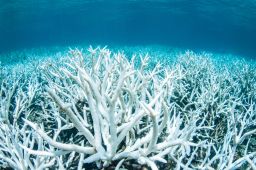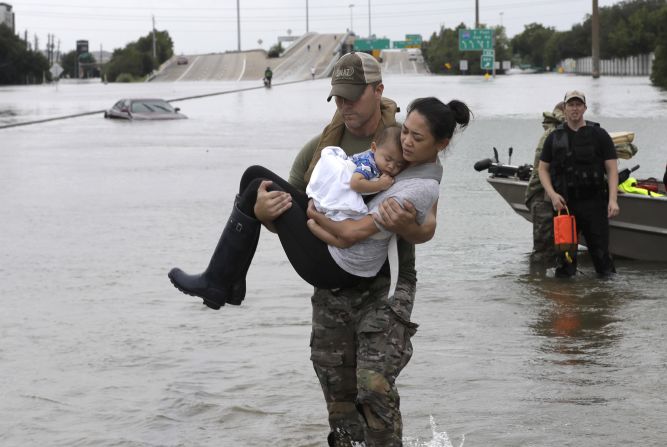Story highlights
17 different extreme events linked to global warming
Some events would not have occurred without warming
"Attribution studies" compare events to historical record
Results can help preparations for future extremes
Extreme weather events that spanned the globe in 2017 have been directly linked to – and in some cases were even caused by – continued warming of the planet via human influence through greenhouse gas emissions, according to a new report.
For the second year in a row, the annual report from the American Meteorological Society found weather extremes that could not have happened without human-caused warming of the climate. Advances in scientific modeling and additional climbs in temperatures are making the connection between global warming and extreme weather much more concrete.
“Global temperature, the backdrop in which extremes are unfolding, continues to rise. … Nature is thereby increasingly rolling back its curtain of sensitivity to rising greenhouse gases,” Martin Hoerling, a research scientist at the National Oceanic and Atmospheric Administration and one of the authors of Monday’s report, wrote in an email.
“This alone is making it easier to scientifically identify the fingerprint of human influence, not to mention improved modeling tools,” Hoerling said.

Scientists found that record warm waters in the Tasman Sea in 2017 and 2018 “were virtually impossible without global warming,” and they concluded that a crippling drought in East Africa that has led to food shortages for millions of people would not have occurred naturally before the Industrial Revolution, when humans began to interfere with the climate system.

Included in the 17 events identified in the report in which global warming played a role were major floods such as those with Hurricane Harvey, fires, heat waves over land and in the ocean, and even record low sunshine in Japan in August 2017.
The findings are part of an annual report titled “Explaining Extreme Events in 2017 from a Climate Perspective,” which reveals clear ties between recent extremes in weather and human influences of the climate.
“This is about understanding that climate is already changing the risks of extremes,” said Jeff Rosenfeld, editor in chief of the Bulletin of the AMS, the journal in which the report was published.
The report features the research of 120 scientists from 10 countries and examines a wide array of extreme weather and events from 2017. The scientists looked at how these events compare with historical observations as well as model simulations to determine whether there was influence from climate change.
These type of comparisons, known as attribution studies, attempt to quantify humans’ role in making certain events more likely, or more extreme, through warming the planet.
“Attribution science has given everyone a rational, quantifiable way to talk about human-caused climate change as it manifests itself to people,” Rosenfeld said, “not as a technical number, a global trend, but as a concrete force in the risks we all face.”
New in this year’s report: perspective essays written by managers and planners in various sectors of society to show the importance the attribution studies and how they can help prepare for and navigate extreme events.
For example, during Harvey, water managers in Texas and Louisiana were challenged with rainfall forecasts far beyond anything ever observed, and according to Julie Vano, a scientist with the National Center for Atmospheric Research who was involved in the report, the managers struggled to believe that much rainfall would actually fall.
Photos: Hurricane Harvey slams Texas
“Attribution studies can be a tool to help us better understand these extremes that are increasingly beyond our experience,” Vano said, but knowing how a warming atmosphere can influence these storms can “help inform their decisions and enhance public safety to reduce impacts of extreme hazards.”
Not every extreme event is made more likely or more impactful by climate change.
According to Hoerling, “over the 7-yr period [that the annual report has been released], about 30% of studies found little to no impact of climate change on an events intensity or likelihood of occurrence.”
But advances in the science of attributing extreme events to climate change are providing useful – and potentially legally necessary – information that must be taken into account by future planners in the public and private sectors.
“This report tells us that the science that informs building safety and structural design criteria – from farms to factories to homes and office buildings – is changing,” Lindene Patton, an attorney with the Earth & Water Law Group, who participated in the study and provided context on how attribution science could lead to legal liability for extreme weather events, wrote in an email.
Patton explained how such things as building codes and spill-protection plans must be created using the knowledge that more severe/intense events are likely due to global warming, and negligence of the matter could create legal liability.
Both the American Society for Civil Engineers and the American Institute for Chemical Engineers are pursuing efforts to evaluate the impacts of climate change on their “best practices” that inform liability, according to Patton.
Extreme events influenced by warming
Heat waves like the one in southern Europe and the Mediterranean in 2017, dubbed “Lucifer” in the media, are now three times more likely than they were in 1950, the report says.
And though it wasn’t included in this year’s report because it happened too recently, extreme drought and heat wave this year in Europe saw temperatures climb above 32 degrees Celsius (90 degrees Fahrenheit) all the way to the Arctic Circle in Scandinavia and unprecedented drought in north and central Europe.
Hurricane Harvey’s rainfall, which totaled over 60 inches over the course of four days in late August 2017, was worsened by a warmer climate providing warmer-than-normal ocean temperatures and more moisture in the air, a fact backed up by multiple studies, the report says.
Not all of the impacts from these climate extremes are direct.
E
xtremely warm sea surface temperatures off the coast of Africa doubled the probability of drought in East Africa, leaving more than 6 million people in Somalia facing food shortages. The analysis in the new report found that such extreme ocean heat would not have occurred in a pre-industrial climate, before human carbon emissions.






























